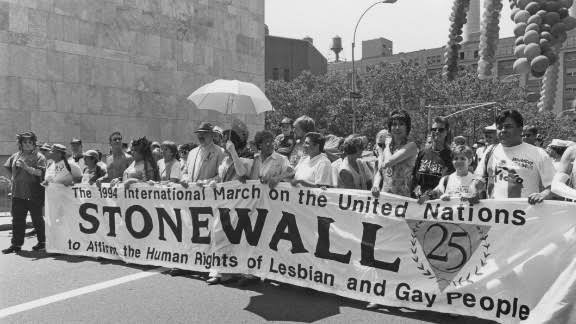The Stonewall Riots, also known as the Stonewall Uprising, began on June 28, 1969, when New York City police raided the Stonewall Inn, a gay club in Greenwich Village, New York. As police dragged staff and guests out of the pub, the raid caused a brawl among bar patrons and local residents, resulting in six days of protests and violent fights with law enforcement outside the bar on Christopher Street, in adjoining streets, and in nearby Christopher Park. The Stonewall Riots sparked the homosexual rights movement in the United States and throughout the world.
Lesbian, homosexual, bisexual, and transgender Americans did not have it easy in the 1960s and prior decades. In New York City, for example, solicitation of same-sex relationships was prohibited.

As a result, LGBT people flocked to gay pubs and clubs, which provided a safe haven where they could express themselves openly and mingle without fear. The New York State Liquor Authority, on the other hand, fined and shut down businesses that served alcohol to known or suspected LGBT people, claiming that simply assembling gays constituted disruptive.
These laws were abolished in 1966, thanks to the efforts of activists, and LGBT consumers could now be offered alcohol. However, because it was still unlawful to engage in gay activity in public (holding hands, kissing, or dancing with someone of the same sex), police harassment of homosexual establishments persisted.
The Genovese crime family owned most Greenwich Village gay clubs by the mid-1960s, after seeing profit in catering to rejected gay clients. They bought Stonewall Inn (a “straight” pub and restaurant) in 1966, restored it for a low price, and reopened it as a homosexual pub the following year.
Read more articles at: https://www.unveil.press/prostitution-and-the-life-of-prostitutes/
Because clients were expected to provide their own booze, Stonewall Inn was classified as a form of private bottle bar, which did not require a liquor licence. To maintain the club’s artificial exclusivity, guests were required to write their names in a book upon entering. The Genovese family bribed the Sixth Police Precinct in New York to disregard the club’s activities.
The crime family could cut expenditures as they saw fit without fear of police intervention: the club lacked a fire exit, flowing water behind the bar to wash glasses, clean bathrooms that didn’t overflow on a regular basis, and edible beverages that weren’t diluted down beyond recognition. Furthermore, the Mafia is said to have blackmailed the club’s richer patrons who sought to conceal their sexuality.
Despite this, Stonewall Inn quickly established itself as a Greenwich Village landmark. It was a big place with a low entry fee. Drag queens were accepted, despite the fact that they were met with hostility in other gay bars and clubs. Many runaways and homeless LGBT youths slept there every night.

Attack on Stonewall Inn
On the morning of June 28, police stormed Stonewall Inn, which came as a surprise because the bar had not been warned off this time.
Police officers entered the club with a warrant, roughed up guests, and arrested 13 people, including staff and those who were breaching the state’s gender-appropriate attire legislation.
Angry clients and area residents remained outside the bar rather than disperse, becoming increasingly irate as the events proceeded and people were forcefully manhandled.When a police officer struck a lesbian in the head while attempting to push her into a police van, she yelled for spectators to intervene, leading the crowd to throw pennies, bottles, cobble stones, and other objects at the officers.
A full-fledged disturbance involving hundreds of individuals broke out within minutes. After repeatedly breaching the wall, the mob attempted to set fire to the barricade, which the police, a few convicts, and a Village Voice journalist locked themselves in.
The crowd was finally dispersed after the fire department and a riot squad were able to put out the flames, rescue individuals trapped inside Stonewall, and put out the fire. However, the protests, which at times drew thousands of people, persisted for another five days in the region, erupting at one point when the Village Voice published its description of the rioting.
On June 28, 1970, one year after the riots, thousands of people marched through Manhattan’s streets from the Stonewall Inn to Central Park in what was then known as “Christopher Street Liberation Day,” America’s first gay pride parade. The official chant for the procession was “Say it loud, gay is proud.”
The site of the riots—Stonewall Inn, Christopher Park, and the surrounding streets and sidewalks—was named a national monument in 2016 by then-President Barack Obama in commemoration of the area’s commitment to LGBT rights.













































